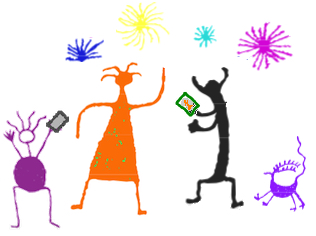
Social media use by
humanitarian agencies: a literature review.
This is a list of research and policy guidelines regarding use of social
media by humanitarian agencies and disaster-response agencies. This is by
no means comprehensive. Using the references in these papers will lead to
even more resources. Also included are resources regarding the ethics of
taking in humanitarian and development situations, and the appropriateness
of using such photos, with an eye to protecting people's rights and
dignity. It's hoped that this can help nonprofits, NGOs, humanitarian
agencies and others to develop appropriate, ethical social media use
policies and procedures.
Social
Media in Emergency Response.
A resource from the U.S. Department of Health & Human Services Assistant
Secretary for Preparedness and Response (HHS ASPR) - specifically, its Technical
Resources, Assistance Center, and Information Exchange (TRACIE),
created to meet the information and technical assistance needs of regional
ASPR staff, healthcare coalitions, healthcare entities, healthcare
providers, emergency managers, public health practitioners, and others
working in disaster medicine, healthcare system preparedness, and public
health emergency preparedness.. This resource focuses on two of the ways
that emergency managers engage in social media: posting information for
public knowledge (e.g., road closures, shelter locations, and weather
updates) and gleaning information to help allocate resources. Disasters
have highlighted the level to which survivors and responders use social
media to communicate about issues such as: their status and location, the
effect of the disaster on their surroundings, where and how to locate
shelter and supplies, how to report to areas that need volunteer support
(and how to make donations over the internet), and strategies for
obtaining medical care. In addition to building community relationships
and setting expectations pre-disaster, planners can use social media to
identify and monitor potential threats to public health, and communicate
with residents about threats (e.g., infectious disease), pending incidents
(e.g., severe weather), and the location and availability of services
(e.g., shelters and points of distribution). Tools such as crowdsourcing
(collecting information from a large group of people via the Internet) and
data mining bolster these efforts. Because the nature of social media
changes so frequently and is used for a wide variety of purposes, the ASPR
TRACIE Team narrowed our search results to include lessons learned and
promising practices from incidents within the past decade and actionable
resources specific to our audience. Resources come from the Center for
Homeland Defense and Security, the Centers for Disease Control and
Prevention (CDC), the Federal Emergency Management Agency (FEMA) and more.
CDC
Guide to Writing for Social Media
This toolkit was developed by the Electronic Media Branch, Division of News
and Electronic Media, Office of the Associate Director of Communication at
the Centers for Disease Control and Prevention (CDC). It was designed to
provide guidance and to share the lessons learned in more than three years
of integrating social media into CDC health communication campaigns,
activities and emergency response efforts. In this guide, you will find
information to help you get started using social media—from developing
governance to determining which channels best meet your communication
objectives to creating a social media strategy. You will also learn about
popular channels you can incorporate into your plan, such as blogs,
video-sharing sites, mobile applications and RSS feeds. This Guide will
focus on three specific channels: Facebook, Twitter, and text messages
(short message service, or SMS). For information on other channels, social
networking sites, and microblogs, visit CDC’s
Social Media Tools, Guidelines and Best Practices.
Using
Social Media in Community-Based Protection.
January 2021. This Guide aims to support UNHCR country offices in the use of
Social Media to protect People of Concern (PoCs) and ensure they enjoy their
rights. Tips include how to set up social media channels for community-based
protection, social media community management, responding to positive and
negative feedback and to questions, create an FAQ, moderation and sensitive
content, rumors and misinformation, feedback and response mechanisms and
social media analytics.
Taking
Photos in Humanitarian Crises.
Guidelines from Oxfam.
Ethics
and images of suffering bodies in humanitarian medicine.
Published in Social Science & Medicine Volume 98, December 2013.
Images taken during a humanitarian crisis and shared on social media can
contribute to the perpetuation of stereotypes of illness, famine or
disasters. This paper illustrates how such representations create problems
in the practice of humanitarian medicine. It uses a concrete example to show
how tensions arise between medical ethics and humanitarian perspectives of
the representations of suffering.
World
Vision Australia Guidelines for online media .
At World Vision, it is our deepest desire to ensure that children and
their families are protected from
the fear or reality of any potential physical or emotional abuse resulting
from inappropriate and unsafe
internet and social media use, including the sharing of private
information about a child and their
family.
We want you to be able to post images and weblogs on the internet in a
meaningful way but without
compromising the dignity of the people you have met or the safety of the
children in the communities
you have visited.
Ethics
and Photography in Developing Countries.
From United for Site. Guidelines that can be helpful in publishing photos on
social media as well. The footnotes are excellent. Those who take photos
while participating abroad have an ethical responsibility to preserve the
dignity of their subjects and provide a faithful, comprehensive visual
depiction of their surroundings so as to avoid causing public
misperceptions. Visual images are a cogent way to convey an experience to
an audience and to evoke strong public emotions, as people often formulate
their opinions, judgments, and behaviors in response to visual stimuli. In
this way, the photographer wields substantial control over public
perception. Photographers’ decisions about how to depict their subjects
can entirely alter viewers’ perceptions.
How
to use social media to engage with people affected by crisis
The International Committee of the Red Cross (ICRC) and the International
Federation of Red Cross and Red Crescent Societies (IFRC), with support from
the United Nations Office for the Coordination of Humanitarian Affairs
(OCHA), have published a brief guide on how to use social media to better
engage people affected by crisis. The guide is geared towards staff in
humanitarian organisations who are responsible for official social media
channels. "The platforms allow local and international actors to better
coordinate relief efforts, and disseminate lifesaving messages in real time.
More importantly, affected communities use the channels to reconnect with
relatives, seek help, and provide feedback and complaints on the (lack of)
assistance received." Also see How
organizations can use social media to better serve crisis affected people.
Best
Practices: The Use of Social Media Throughout Emergency & Disaster
Relief
By Erica Goldfine, April 28, 2011, submitted to the faculty of the Public
Communication Graduate Program, School of Communication, American
University, Washington, DC., in Candidacy for the Degree of Master of Arts.
This study sets out to understand how social media is being used in
disaster and emergency situations. Research thus far has established the
importance of social media in disaster and crisis communication but
neglects to describe why social media are important. To establish best
practices of social media use in a disaster and why they should be used,
this study interviewed six communication or social media experts in the
field of disaster relief. The following four best practices were
established: plan for social media use before a disaster occurs, utilize
popular and relevant social media tools, localize disasters in social
media use, and utilize mapping efforts. These best practices explain the
best ways to utilize social media in disaster relief as well as explain
why those tools will work best.
Ethics in
Nonprofit photography
A list of policies and considerations for taking photos in nonprofit work.
Practical, straight-forward information. .
Fifteen
years of social media in emergencies: A retrospective review and future
directions for crisis Informatics
By Christian Reuter and Marc-André Kaufhold. Published: 27 September 2017. This
article aimed to recapitulate 15 years of social media in emergencies and
its research with a special emphasis on use patterns, role patterns and
perception patterns that can be found across different cases to point out
what has been achieved so far, and what future potentials exist.
Ethics in
Nonprofit photography
A list of policies and considerations for taking photos in nonprofit work.
Practical, straight-forward information. .
wateraid.org
Ethical Image Policy
The gathering of images can cause harm if it is not carried out to a high
ethical standard and they can cause offence if they are intrusive or
inappropriate. The use of images can also be counter-productive if they
are reproduced inaccurately or with manipulation. As a people-centred
organisation, we must do our utmost to ensure we treat people with dignity
and respect. This extends to all aspects of image gathering and
reproduction.
Ethical
Considerations When Using Social Media for Evidence Generation
A publication from UNICEF. When engaging with social media and indeed
most technology, thoughtfulness, reflection and ongoing interrogation is
required. This paper examines the benefits, risks and ethical
considerations when undertaking evidence generation: (a) using social
media platforms and (b) using third-party data collected and analysed by
social media services. It is supplemented by practical tools to support
reflection on the ethical use of social media platforms and social media
data.
Disaster
Management and Social Media Use for Decision Making by Humanitarian
Organizations
Published in: 2016 49th Hawaii International Conference on System Sciences
(HICSS). In times of a crisis, disasters or extreme events, affected
people use social media solutions to share information about the
situation. Hence, the use of this information for supporting humanitarian
operations is becoming a valuable source to develop a real time
understanding about the situation even before they arrive at the ground.
From a scholarly perspective, the use of social media management during
and after a disaster has hit has been researched, but no special focus has
been given to the needs of humanitarian organizations and how their
management phases can be supported by social media analytics in real time.
In this research, we will identify the few papers that have been concerned
with this topic and will apply a theoretical lens from disaster management
to investigate viable areas where social media research can support
humanitarian organization in the different phases of disaster response.
The
Rise of the Digital Humanitarian: How Social Media is Changing Crisis
Situations, and What Any Leader Can Learn from It.
2014. Digital humanitarians are volunteers from all over the world who
support research and relief efforts through online work. Digital
humanitarianism can make vital information available faster – sometimes days
or weeks faster – than the slow and sometimes conflicting trickle of
information available on the ground. Crisis mapping is one common
means of digital humanitarianism. In the days following the Haiti
earthquake, volunteers combed through victims’ texts, Facebook posts, and
other online messages and the information they gathered was curated and
compiled online to help disaster-response organizations determine when and
where to deliver aid. Crisis mappers layer social media generated data with
satellite imagery when available to evaluate road conditions in crisis
areas, providing up-to-the-minute maps for aid organizations. What does it
mean to be a digital humanitarian, and how is it changing disaster response?
Dr. Kerrie Aman Carfagno, McIntire School of Commerce Lecturer at the
University of Virginia and graduate of the Center for Values-Driven
Leadership’s doctoral program, set out to discover exactly that through her
dissertation on the role of social media in crisis management. Carfagno
interviewed eight “digital superheroes,” as she calls them: leaders in
organizations including governmental, consulting, non-profit, and
for-profit. Interviewees spoke of their first-hand experiences with social
media in 50 crisis situations, including the Boston Marathon bombing, the
Westgate Mall attack in Nairobi, and other natural and manmade disasters
around the globe. Organizations’ Dialogic Social Media Use and Stakeholder
Engagement: Stakeholder Targeting and Message Framing
By Chih-Hui Lai, Jiawei Sophia Fu. Guided by the dialogic communication
framework, stakeholder theory, and research on implicit framing, this study
examines how stakeholder engagement reflects organizations’ dialogic social
media use in the form of stakeholder targeting and message framing. Analysis
of survey data from 156 humanitarian organizations and semantic network
analysis of their messages on Facebook and Twitter reveal that organizations
with higher levels of dialogic social media use target relatively
distinctive stakeholders. More dialogic organizations explore more diverse
concepts in their posts, but the themes of discussion on Twitter and
Facebook both diverge and converge regardless of levels of dialogic social
media use. Moreover, the semantic differences among the organizations in the
low- and high-dialogic groups are more salient on Twitter than on Facebook.
Theoretical contributions and practical implications are drawn from the
findings.
Organizations’
Dialogic Social Media Use and Stakeholder Engagement: Stakeholder
Targeting and Message Framing
By Chih-Hui Lai, Jiawei Sophia Fu. Published in the International
Journal of Communication in 2020. Abstract: Guided by the dialogic
communication framework, stakeholder theory, and research on implicit
framing, this study examines how stakeholder engagement reflects
organizations’ dialogic social media use in the form of stakeholder
targeting and message framing. Analysis of survey data from 156 humanitarian
organizations and semantic network analysis of their messages on Facebook
and Twitter reveal that organizations with higher levels of dialogic social
media use target relatively distinctive stakeholders. More dialogic
organizations explore more diverse concepts in their posts, but the themes
of discussion on Twitter and Facebook both diverge and converge regardless
of levels of dialogic social media use. Moreover, the semantic differences
among the organizations in the low- and high-dialogic groups are more
salient on Twitter than on Facebook. Theoretical contributions and practical
implications are drawn from the findings.
Examples
of a Social Media Policy for Non-Profit Organizations
The Houston Chronicle examined the social media policies of four nonprofits
- National Public Radio, International Red Cross, Smithsonian Institution
and the The American Institute of Architects - and found several common
themes are apparent, despite the diverse purposes of these organizations.
Also see:
- Daily, Mandatory, Minimal Tasks for Nonprofits
on Facebook & Twitter
There are a lot of nonprofits using Facebook and Twitter just to post to
press releases. And if that's how your nonprofit, NGO or government
agency is using social media, then your organization is missing out on
most of the benefits you could gain from such. Facebook, Twitter and
other social media are all about engagement. Social media is NOT one-way
communication; you want people and organizations to read your
information, but you also want them to respond to it. And they want YOU
to respond to what THEY are saying. I broke these must-do tasks down
into the most simple, basic list as possible - these tasks take minutes,
not hours, a day.
- The Nonprofit & NGO Guide to Using Reddit
As of July 2019, Reddit ranked as the No. 5 most visited website in the
USA and No. 13 in the world. Reddit is a community of communities, and
its communities are called subreddits. A subreddit can have a focus on a
geographic area, a book, a celebrity, a particular time in history, a
specific hobby - anything. Statistics suggest that 74% of Reddit users
are male. Users tend to be significantly younger than other online
communities like Facebook with less than 1% of users being 65 or over.
If you want to reach a younger demographic regarding your volunteering
opportunities, your awareness messages, your data that shows your value
to the community and more, you need to build posts to Reddit into your
marketing strategy, no matter what your nonprofit's size or focus. This
resource tells you how to do it.
- Evaluating
Online Activities: Online Action Should Create & Support Offline
Action
Hundreds of "friends" on an online social networking site. Thousands of
subscribers to an email newsletter. Dozens of attendees to a virtual
event. Those are impressive numbers on the surface, but if they don't
translate into more volunteers, repeat volunteers, new donors, repeat
donors, more clients, repeat clients, legislation, or public pressure,
they are just that: numbers. For online activities to translate into
something tangible, online action must create and support action. What
could this look like? This resource can help organizations plan
strategically about online activities so that they lead to something
tangible - not just numbers.
- How to handle online criticism of your
organization.
- The
importance of Twitter lists
- The
awesome power of tweet tags
- Why
I won’t follow you on Twitter
- 14
(was 13) things you do to annoy me on social media
A tongue-in-cheek effort to encourage mission-based organizations to do
a better job with Twitter, Facebook, Instagram and other social
networking sites.
- Facebook
use to organize Women’s Marches: lessons learned
Facebook was an essential tool in organizing women’s marches all over
the USA in January 2017. They may have been the largest single day of
marches in US history. This blog is a list of things I learned observing
the online organizing first hand.
- The
dark side of the Internet for mission-based organizations
- Measuring
social media success? You’re probably doing it wrong.
- Volunteers
can help you reach more people on Facebook
- Snapchat’s
Potential Power for Social Good – with REAL examples.
- Stages
of Maturity in Nonprofit Orgs Using Online Services.
- How
Not-for-Profit and Public Sector Agencies REALLY Use Online
Technologies
- Police:
use social media to invite community participation, show compassion
- Addressing
criticism, misinformation & hate speech online
- What are good blog topics for mission-based
organizations?
The word "blog" is short for "web log", and means keeping a journal or
diary online. Blogging is NOT a new concept -- people have been doing it
long before it had a snazzy media label. The appeal of blogging for an
online audience is that it's more personal and less formal than other
information on a web site. Readers who want to connect with an
organization on a more personal level, or who are more intensely
interested in an organization than the perhaps general public as a
whole, love blogs. Blogs can come from your Executive Director, other
staff members, volunteers, and even those you serve. Content options are
many, and this list reviews some of
your options
Quick Links
 my home
page
my home
page
 my
consulting services & my workshops
& presentations
my
consulting services & my workshops
& presentations
 my
credentials & expertise
my
credentials & expertise
 Affirmation that this web site is
created & managed by a human.
Affirmation that this web site is
created & managed by a human.
 My book: The
Last Virtual
Volunteering Guidebook
My book: The
Last Virtual
Volunteering Guidebook
 contact me
or see my
schedule
contact me
or see my
schedule
 Free Resources: Community Outreach, With & Without Tech
Free Resources: Community Outreach, With & Without Tech
 Free Resources: On
Community Engagement, Volunteering & Volunteerism
Free Resources: On
Community Engagement, Volunteering & Volunteerism
 Free Resources: Technology
Tips for Non-Techies
Free Resources: Technology
Tips for Non-Techies
 Free Resources:
Nonprofit, NGO & other mission-based management resources
Free Resources:
Nonprofit, NGO & other mission-based management resources
 Free Resources: Web
Development, Maintenance, Marketing for non-Web designers
Free Resources: Web
Development, Maintenance, Marketing for non-Web designers
 Free Resources: Corporate
philanthropy / social responsibility programs
Free Resources: Corporate
philanthropy / social responsibility programs
 Free Resources: For people
& groups that want to volunteer
Free Resources: For people
& groups that want to volunteer
 linking to
or from my web site
linking to
or from my web site
 The
Coyote Helps Foundation
The
Coyote Helps Foundation
 me on
social media (follow me, like me, put me in a circle,
subscribe to my newsletter)
me on
social media (follow me, like me, put me in a circle,
subscribe to my newsletter)
 how to
support my work
how to
support my work
To know when I have developed a new
resource related to the above subjects, found a great
resource by someone else, published
a
new blog,
uploaded a new
video,
or to when & where I'm training or presenting, use any
of the following social media apps to follow me on any of
these social media platforms:






Disclaimer: No guarantee of accuracy or suitability is made by
the poster/distributor of the materials on this web site.
This material is provided as is, with no expressed or implied
warranty or liability.
See my web site's privacy
policy.
Permission is granted to copy, present and/or distribute a limited
amount of material from my web site without charge if
the information is kept intact and without alteration, and is
credited to:

Otherwise, please contact me
for permission to reprint, present or distribute these materials
(for instance, in a class or book or online event for which you
intend to charge).
The art work and material on
this site was created and is copyrighted 1996-2025
by Jayne Cravens, all rights reserved
(unless noted otherwise, or the art comes from a link to
another web site).



 my home
page
my home
page my
consulting services & my workshops
& presentations
my
consulting services & my workshops
& presentations my
credentials & expertise
my
credentials & expertise Affirmation that this web site is
created & managed by a human.
Affirmation that this web site is
created & managed by a human. My book: The
Last Virtual
Volunteering Guidebook
My book: The
Last Virtual
Volunteering Guidebook contact me
or see my
schedule
contact me
or see my
schedule Free Resources: Community Outreach, With & Without Tech
Free Resources: Community Outreach, With & Without Tech Free Resources: On
Community Engagement, Volunteering & Volunteerism
Free Resources: On
Community Engagement, Volunteering & Volunteerism Free Resources: Technology
Tips for Non-Techies
Free Resources: Technology
Tips for Non-Techies Free Resources:
Nonprofit, NGO & other mission-based management resources
Free Resources:
Nonprofit, NGO & other mission-based management resources Free Resources: Web
Development, Maintenance, Marketing for non-Web designers
Free Resources: Web
Development, Maintenance, Marketing for non-Web designers Free Resources: Corporate
philanthropy / social responsibility programs
Free Resources: Corporate
philanthropy / social responsibility programs Free Resources: For people
& groups that want to volunteer
Free Resources: For people
& groups that want to volunteer linking to
or from my web site
linking to
or from my web site The
Coyote Helps Foundation
The
Coyote Helps Foundation me on
social media (follow me, like me, put me in a circle,
subscribe to my newsletter)
me on
social media (follow me, like me, put me in a circle,
subscribe to my newsletter)